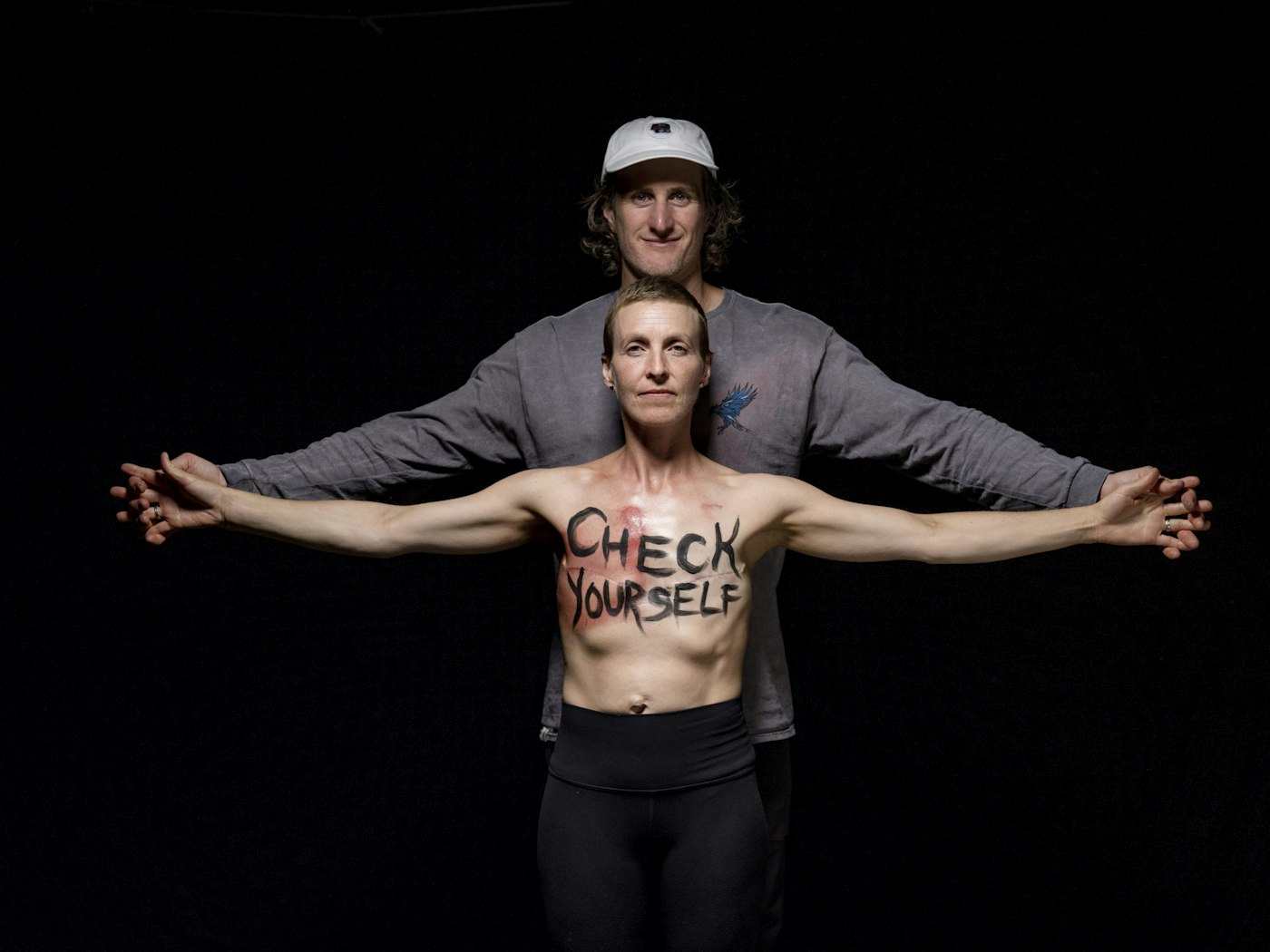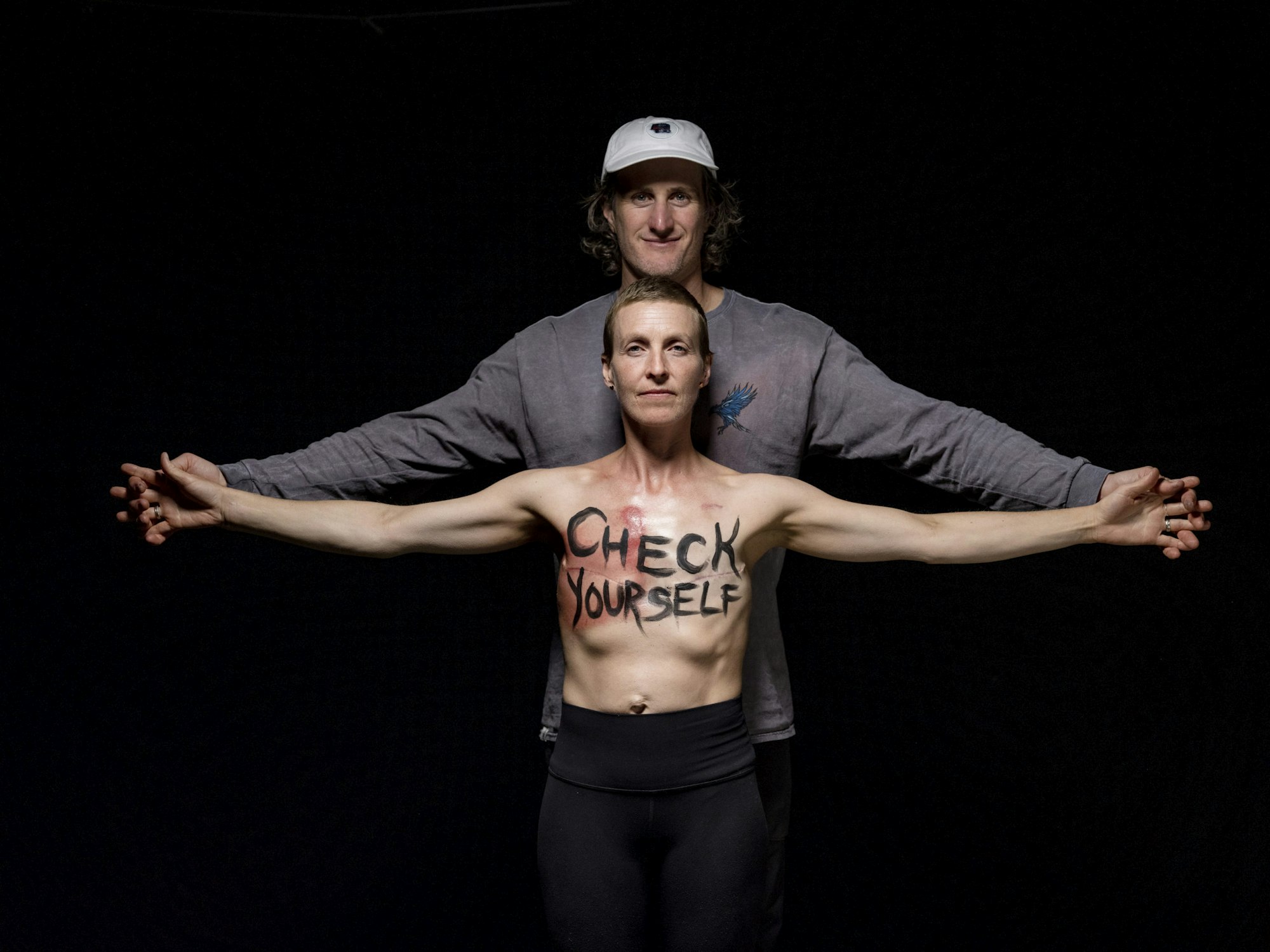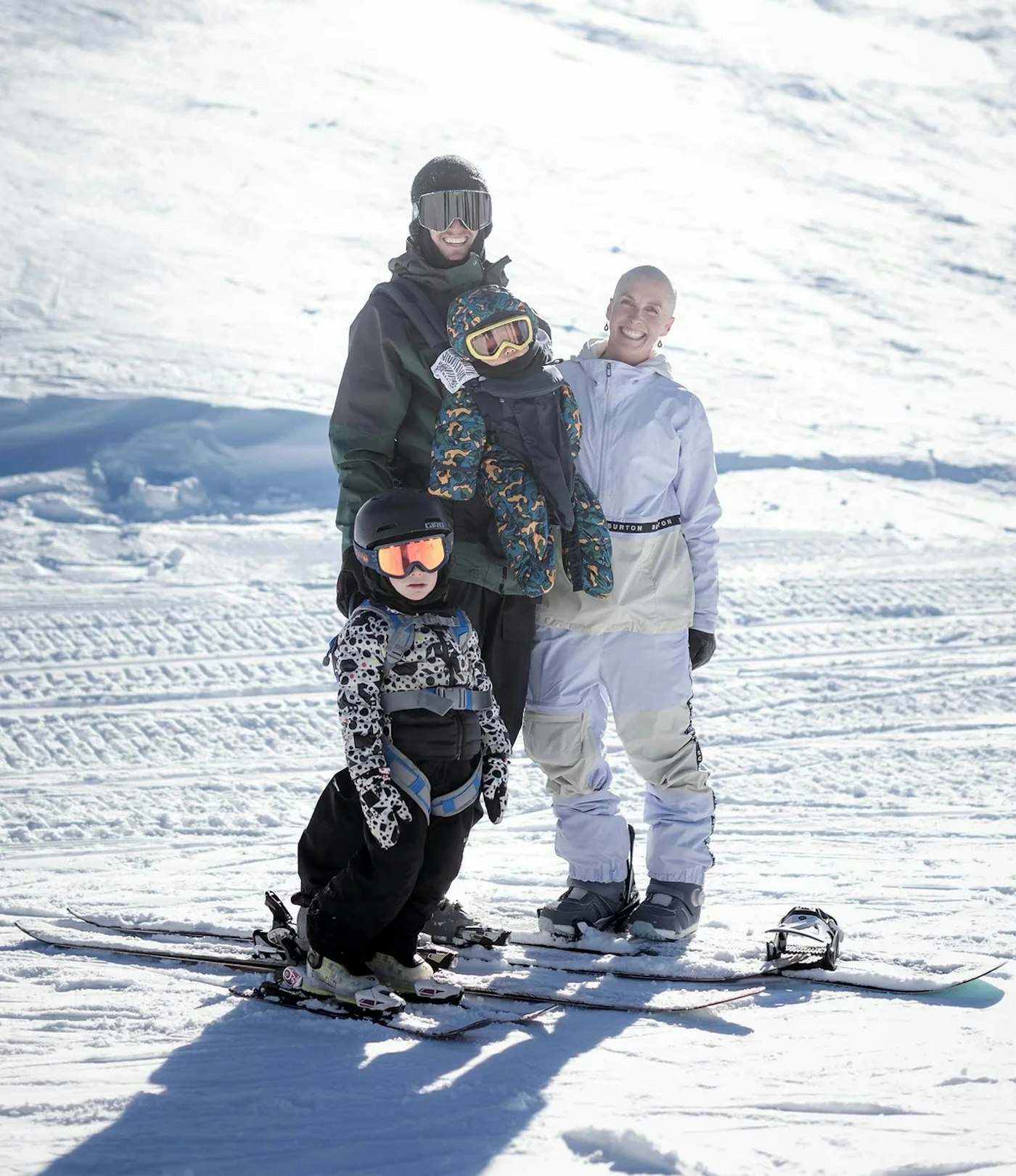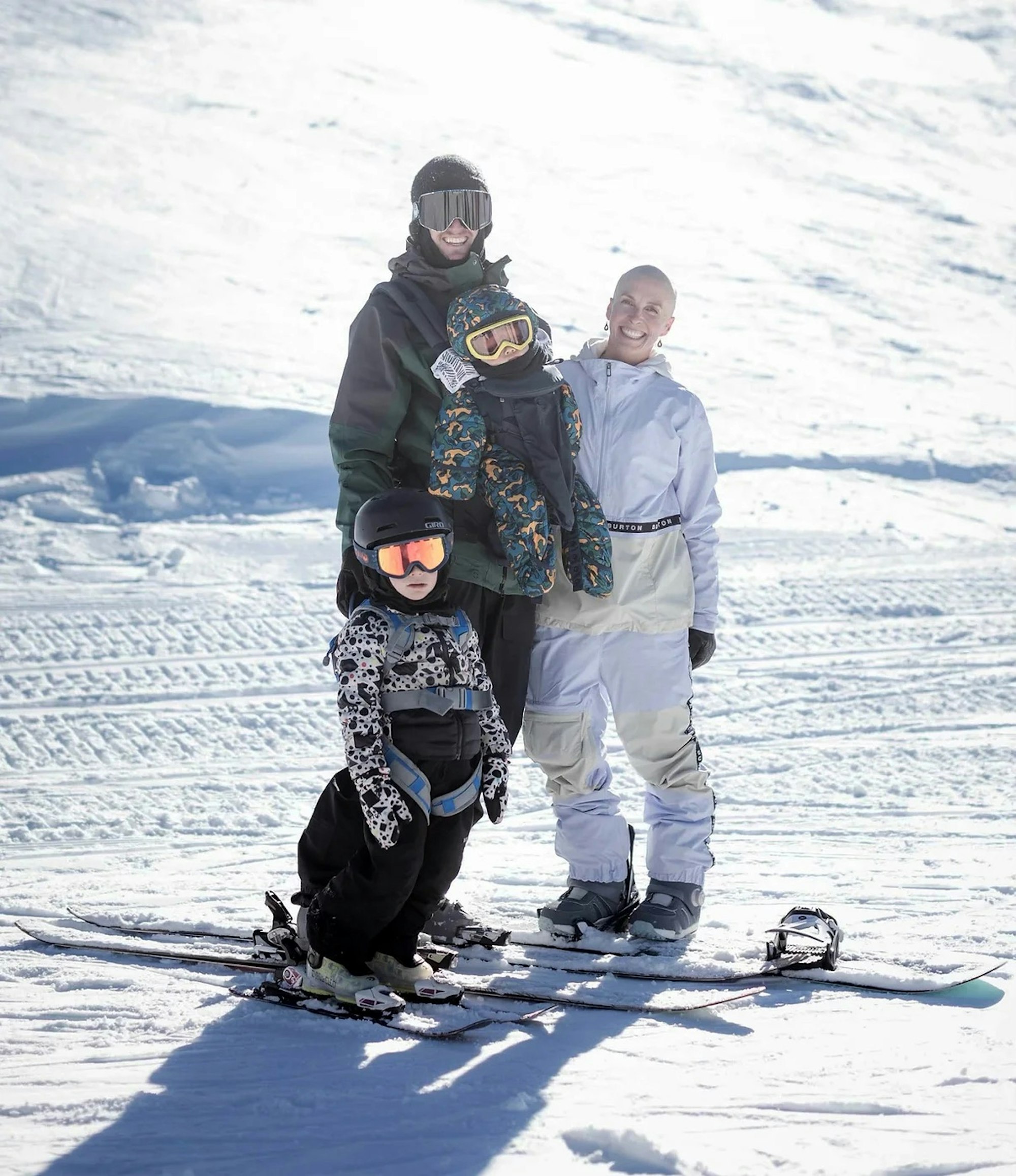Featured image: Courtesy of Atomic
Chris Benchetler has been a key figure in the ski industry for over half his life. Hell, his wildly popular freeride skis, the Bent Chetlers, have been coming out of the Atomic factory for 15 years. 16 if you count the skis he’s currently working on for next season. Whether he’s laying out beautiful arcs in the backcountry, or expressing his creativity on a canvas, the prolific pro skier is known for his unique take on skiing, art and life.
These days, the father of two is juggling a lot more than he ever thought possible—both exciting opportunities and devastating hardship. Recently named Creative Director of Freeride and Freeski, Benchetler has a new title over at Atomic and will continue to lead the development and design of his namesake ski line.
On the other side of the curtain, last November, Benchetler’s wife and professional snowboarder, Kimmy Fasani, was diagnosed with stage 3 inflammatory breast cancer, a very rare and aggressive type of the disease. The two have both lost parents to cancer and bonded over the mutual hardship and loss when they first met as teenagers and have continued to heal together, within nature, ever since. After Fasani’s diagnosis, the two acted fast in her treatment, as well as developing a nonprofit organization to help others dealing with loss and hardship find healing in the outdoors, the Benchetler Fasani Foundation. We caught up with Benchetler to talk about his new role at Atomic, what he hopes to achieve with the foundation as well as ski plans for the upcoming season. Keep reading for the full interview.
How are you? How has your summer been?
How long would you like this interview to be? [laughs] I’m great; it’s been a rollercoaster of more than just a summer, this entire year. Being a father of two and having a wife battling such aggressive cancer, it’s been emotional, it’s been beautiful, it’s been challenging, it’s been… everything, really.
Itching for ski season yet?
I sure am! I didn’t get to ski much last year, the days I did have on the hill were with my children because Kimmy was basically [on a schedule of] one week down in chemotherapy and then two weeks home; the first week she’d get back home she was pretty worked, so I essentially was a solo dad for two weeks and then that third week she’d feel good enough to jump back in and hang with the kids. I would try to get out occasionally, but all of that mixed with a pretty bad ski season, I really put very few days on the slopes, so I am absolutely looking forward to it and itching and hoping that we, North America, have a good season. I have a couple trips in motion, so I’m keeping my fingers crossed.
You were recently named Atomic’s new Creative Director of Freeride and Freeski. What are you most excited to pursue in the position?
I’m excited about a lot of things that come in conjunction with this new role. It’s very much the same role that I had been developing these last few years—given the demand for my art and the expansion of the Bent line, there was more opportunity for me to get involved on a design-heavy level. So just talking with the brand and all the wonderful people I work with frequently, we were trying to get creative—no pun intended—on the way we could utilize me and give me a forward-facing title. Every band needs a frontman, if you will, and there are incredible designers and other art directors that work for the brand that I just work hand-in-hand with. This was just a way to expand what I was already doing, but ultimately I have a lot of the same responsibility that I always had.
To answer your question about what I’m most excited about is just making sure that the athletes have the most authentic voice possible and that we’re listening to not only myself now, but getting everyone’s perspective. Having a bigger voice internally in the brand is always helpful, Atomic in particular, has always been really wonderful and listened to my voice but I think now having a role that I can call Sage or Daron or Jossi or whoever it is, and just make sure the ski flex and design is speaking to them and reacting the way they want it to react. And then from an art perspective, I really do like to have no direction when I’m painting. I want everything to be my emotion and experience coming through colors and compositions, basically, and Atomic has always allowed me to do that. I get to continue to create and mock things up on skis and send it out to the whole team and make sure everyone likes the direction it’s headed and go from there. So my job is really just getting to paint a lot and keep in touch with everyone at the brand.
Any apprehensions about the new role?
I do not. I have been with the brand for so long now, I think we’ve done 15 years (16 years technically) because we’re always a bit ahead with my designs. I knew what I was getting into. A lot of the people behind the scenes are the same people I’ve worked with for over a decade now. I have a lot of trust in their vision and they respect and believe in my vision, so I think it will be very in-line with what we’ve been doing in the past. I’m very lucky that it’s not giving me more computer time or meetings. I’ve already got a pretty good workflow with Atomic, so it’s just come down to having a role that people can reflect internally or call me on the outside.


You started the Benchetler Fasani Foundation with your wife and partner, Kimmy. What do you hope to achieve with this foundation?
A lot, really. The backstory is that we’ve both lost parents to cancer, she’s lost both her mom and dad and I lost my father, so there’s been this deep understanding between the two of us and a deep connection. That’s really what ultimately fast-tracked our relationship, understanding the concept of death, what it’s like to lose someone and how you find the light after that. I think we both found so much peace in skiing and snowboarding and being in nature that we’ve known that we wanted to share that with people who have suffered hardship or loss. When Kimmy was diagnosed with cancer, it hit really close to home because there’s obviously the unknowns of if she’s going to survive and what that looks like for our children.
[The Foundation] ended up being much harder than either of us anticipated but I think having our social network and just network in general, the platform to be able to reach a lot of people who have suffered—it can be cancer, it’s not cancer-specific, it’s just if you’ve suffered hardship or loss, it can be loss of someone in a car crash or, you know, we just lost our beloved Hilaree [Nelson] to the mountains and JP Auclair left a son behind. There are so many people that have hard experiences to deal with and leave kids behind or partners behind, so we just want to use this platform to create an opportunity for people to get into nature and find healing in that environment. That’s really the basic goal, just create opportunities and experiences for people who otherwise can’t get those experiences. Whether it’s someone who has never been on a pair of skis getting lessons up at Mammoth, or someone who’s a bit more advanced but wants to get into the backcountry, we can help supply guides. Just trying to create these life-changing experiences for people who have had a hard road.
For now, our non-profit is a pass through, we want to give grants and experiences. We don’t have the insurance in place or anything set up at this time to give the experience ourselves, so there are so many incredible nonprofits that offer unique experiences that we want to partner with, like Boarding for Breast Cancer. As we learn how to navigate this space, we can be a pass-through to get people to those nonprofits. We wanted to launch this foundation while we were going through such a hard time because it’s a very meaningful and compelling part of Kimmy’s journey to give back even though she still needs to give to herself and get herself back in nature. It’s a learning process but we just really want to get people outside to feel the good vibes of the universe.
You say that nature heals, can you expand on that notion?
It’s deep but nature has always been my biggest teacher. It’s very transparent in my artwork if you look at it literally or metaphysically. I think it’s the quiet, the power and beauty of nature. The scared feeling you get when you’re standing on top of a line is adrenaline and it’s something that your body naturally releases. The surroundings and being out in nature are the antidote for that stress. It takes that feeling away by reducing anxiety and lowering stress hormones, allowing you to find peace in what you’re doing. I think the reason some people turn to darkness and drugs after hardship is because it’s managing those same chemical imbalances and providing an outlet from reality. Nature offers that same stress relief, but in a very pure and healthy way.


PHOTO: Aaron Blatt
Your boys are getting older, how has it been navigating your entire family through this healing process and evolution of life?
Having children is extremely difficult [laughs] and it’s exposed a lot of my flaws as a human. My patience and my threshold has changed while dealing with all of this just because I’m trying to process myself and deal with my own emotions. Then I have a four-and-a-half year old and a one-and-a-half year old, those ages have big emotions and they’re learning it all. They can read the energy and feel the difficulty that we’re going through in the house, so it’s been really hard to navigate. It’s been overwhelming at times, but we’ve had such an incredible community of friends that have wanted to help and have come to help me watch the kids and make sure that we’re keeping it as fun as possible. In the hard times kids just want to feel safe and have fun and want you to be present, as long as you can do all of those things, they seem pretty content. So that’s been my biggest effort, being as present as possible with them and trying to keep them outside and in nature for the same reasons we started the nonprofit. I wanted to make sure they were spending time skiing, trying to bike or rock climb, whatever sports we do as a family, even though mom wasn’t quite able to join us for a lot of it.
How has your art evolved, if at all, through this process? Have you noticed a visual change going through all of this?
Absolutely. Evolution in my art was coming regardless, but as I said earlier in the conversation, my art is very much my emotions translated into colors and compositions on a canvas. It’s been an extremely emotional time and there’s a depth to my work already that I just have in there for people to dissect how they will, that’s just how art is, but it’s become more obvious. There are more figures of Kimmy and her emotions and the process that I’m seeing her go through. It’s obviously not her creating the art so it’s from my perspective, but it’s very much tied into this whole journey. There’s been a lot of expansion in my work and breakthroughs for myself, deconstructing perfectionism and all these different things and really trying to drive more abstract ideas that I wasn’t scared to try before but didn’t know if it was the right time. So now I just feel inspired to go for it, I guess. Because I have a studio in my home, I’ve been able to paint more than usual while the youngest is napping and the oldest is in preschool. While I was home alone it was my meditation and therapy, so I was painting a lot and I’ve created a lot of work this last year and a lot of meaningful work.
You weren’t able to get on your skis much last season, is there anything specific you’re hoping to do on your skis this year? Any projects in the works?
There are projects. There are some that are more long-term projects, so I’m focused on just trying to make those happen. There’s always been a little glimmer of hope of doing another Fire on the Mountain, can’t say for certain that that’s coming in the future but there is interest on multiple levels; from myself, from the film crew and from The Dead, also. I’m exploring those ideas internally and then I have some other concepts that I want to do with Mammoth Mountain. I have a GoPro trip already on the books, up to British Columbia, which I’m excited about.
What does the perfect ski day look like to you these days?
I would say I’ve found the most joy in seeing the excitement and progression in my oldest son, watching him ski. It definitely beats any powder day I’ve had, just sharing that joy with another human and seeing them take to it themselves. So the perfect ski day would be maybe fresh tracks for myself to be a little selfish in the morning, go for two laps on the mountain before it gets tracked, then a quick tour to one of my favorite zones close by and then be home by lunch to take my children skiing for the afternoon.
![[Q&A] Catching up with Chris Benchetler about his new role at Atomic and launching the Benchetler Fasani Foundation](https://www.datocms-assets.com/163516/1751490758-fs_benchetler_qa.jpg?auto=format&bg=FFFFFF&w=100)
![[Q&A] Catching up with Chris Benchetler about his new role at Atomic and launching the Benchetler Fasani Foundation](https://www.datocms-assets.com/163516/1751490758-fs_benchetler_qa.jpg?auto=format&bg=FFFFFF&w=1200)

![[GIVEAWAY] Win a Head-to-Toe Ski Setup from IFSA](https://www.datocms-assets.com/163516/1765920344-ifsa.jpg?w=200&h=200&fit=crop)


![[GIVEAWAY] Win a Legendary Ski Trip with Icelantic's Road to the Rocks](https://www.datocms-assets.com/163516/1765233064-r2r26_freeskier_leaderboard1.jpg?auto=format&w=400&h=300&fit=crop&crop=faces,entropy)




![[GIVEAWAY] Win a Head-to-Toe Ski Setup from IFSA](https://www.datocms-assets.com/163516/1765920344-ifsa.jpg?auto=format&w=400&h=300&fit=crop&crop=faces,entropy)


![[Q&A] Catching up with Chris Benchetler about his new role at Atomic and launching the Benchetler Fasani Foundation](https://www.datocms-assets.com/163516/1751490758-fs_benchetler_qa.jpg?auto=format&bg=FFFFFF&w=2000)